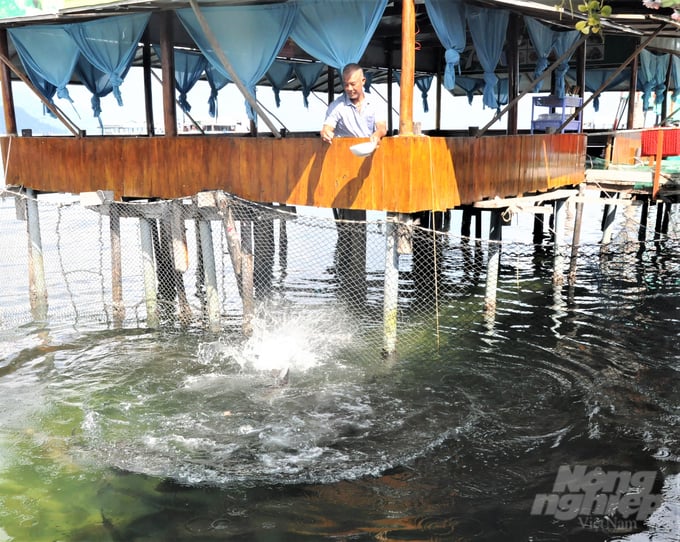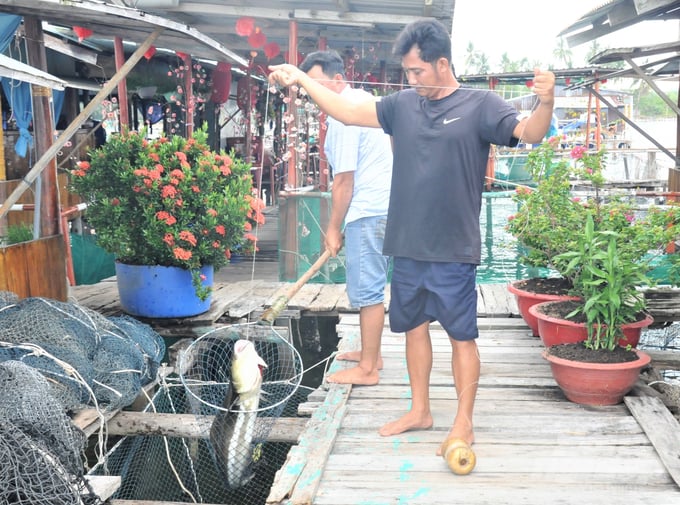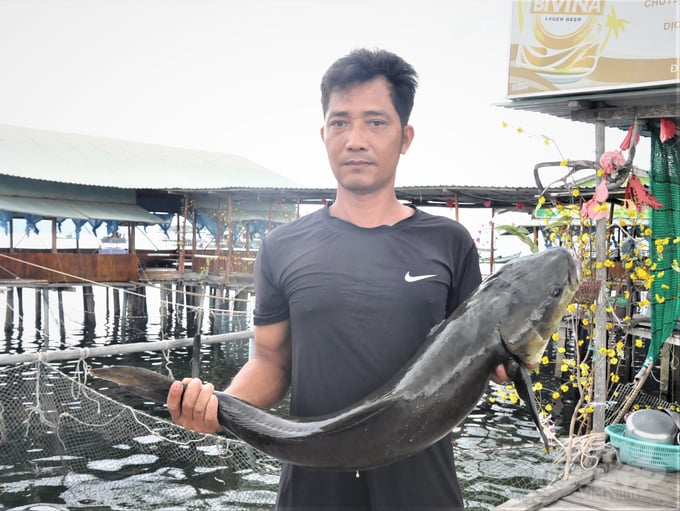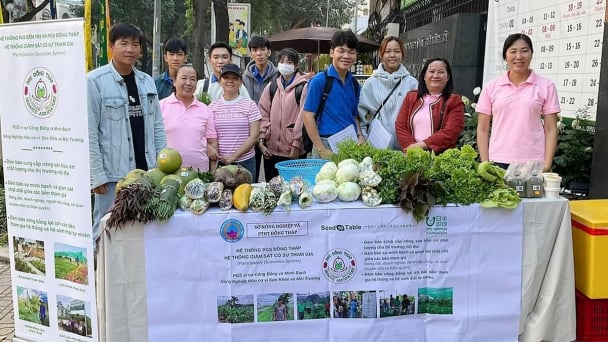May 23, 2025 | 06:18 GMT +7
May 23, 2025 | 06:18 GMT +7
Hotline: 0913.378.918
May 23, 2025 | 06:18 GMT +7
Hotline: 0913.378.918

Phu Quoc's marine environment, with high water quality and mild weather conditions, is highly conducive to aquaculture development. Photo: Trung Chanh.
The majority of communes and wards within Phu Quoc city engage in coastal aquaculture activities.
Aquaculture activities in Phu Quoc city, Kien Giang province, was primarily small-scale and spontaneous from 2010 to 2023; with a focus on three main farming groups: fish in cage, spotted Babylon snails, and pearl oysters. The local broodstock is sourced from other regions within the province. Local farmers initially feed the fish with fresh food; however, there has been a transition to industrial feed and trash fish.
The scale and output of aquaculture activities in Phu Quoc remained relatively steady from 2010 to 2023, with between 500 and 600 farming cages, and an average annual yield of approximately 500 tons. The number of cages increased significantly, reaching 700 cages, in 2016. The highest yield was recorded in 2018, at over 1,000 tons.
Phu Van Bao, a farmer from Ganh Dau commune, Phu Quoc city, is experienced in the exploitation of marine resources. As fishing activities became increasingly challenging due to depleted marine resources, he transitioned to mariculture within the last ten years. He selected the marine area of Rach Vem hamlet in Ganh Dau commune to anchor his fish cages over a marine surface area of more than 1 hectare. Additionally, he utilized the houseboat as a site to provide tourists with dining and sightseeing services.
Sharing the same hope as other mariculture farmers, Bao expects local governments to promptly complete the procedures for stable marine surface area allocation; thereby facilitating investment in modern cages and the transition to industrial feed in order to reduce pollution and costs. He remarked, "I have been applying for marine surface area allocation for nearly ten years; however, the local government have yet to consider and issue the lease for aquaculture according to regulations."

Phu Quoc city encourages its fishermen to gradually transition from traditional cages to modern HPDE cages. Photo: Trung Chanh.
Truong Xuan Nhon, Deputy Head of Phu Quoc city's Economic Department, stated that the city is currently implementing policies to support and encourage its fishermen to gradually transition from traditional cages to modern HPDE cages. Additionally, the city is reviewing and allocating marine surface areas to households and mariculture facilities.
Phu Quoc city aims to have at least 920 mariculture cages by 2025, which include 700 traditional cages, 20 high-tech cages with a diameter of 60 meters, and 200 other aquaculture cages. Additionally, the city aims to establish a 500-hectare cage mariculture area, with a volume of 300,000 cubic meters. Accordingly, mariculture yield is projected to reach 3,470 tons, including 1,870 tons from high-tech cages.
The province plans to increase the number of mariculture cages to 1,100 by 2030, which include 100 high-tech cages. Similarly, the cage mariculture area is projected to expand to 650 hectares, with a volume of 425,000 cubic meters. Accordingly, mariculture yield is projected to reach 6,200 tons, including 4,400 tons from high-tech cages.
According to the mariculture development plan from 2023 to 2025, with a vision towards 2030, the city is establishing a zoning map for mariculture activities with the goal of promptly allocating marine surface areas to local residents. This initiative corresponds with the city's implementation plan for the 2017 Law on Fisheries, as approved by Phu Quoc City Chairman Huynh Quang Hung.
Phu Quoc city aims to effectively manage local mariculture facilities and, by 2030, all such facilities in the city, with various farming subjects and methods, will be organized and zoned accordingly. Additionally, all facilities must complete the necessary registration procedures for mariculture as per regulations; apply information technology for scientific and strict management; maintain traceability of products; and promote the sustainable development of the mariculture sector.

The majority of communes and wards in Phu Quoc city engage in coastal aquaculture activities, which provide a livelihood for the local fishermen. Photo: Trung Chanh.
Mariculture areas in Phu Quoc city will include cage and mollusk farming in Rach Vem and Chuong Vich hamlets in Ganh Dau commune, Rach Tram hamlet in Bai Thom commune, Tho Chau commune, An Thoi ward; and pearl oyster farming in Duong To commune. In addition, the arrangement and organization of mariculture areas must promote a focused and sustainable production chain that prioritizes compliance with the 2017 Law on Fisheries.
Chairman Huynh Quang Hung emphasized that the city is restructuring the fisheries sector based on a balanced approach between exploitation and aquaculture to ensure effectiveness and sustainable development. Moreover, the city aims to gradually reduce the number of fishing vessel and the volume of catches in order to facilitate the transition towards mariculture, thereby alleviating pressure caused by coastal fisheries exploitation activities. The materials for frames, buoys, nets, and traps must be non-polluting to the environment, non-toxic to the farmed species, and prevent the escape of farmed species into the environment. Consequently, Phu Quoc city aims to increase the scale, productivity, and output of mariculture; ensure food safety; create employment opportunities; and enhance the income of coastal communities.
Accordingly, Phu Quoc City People's Committee has assigned its Department of Natural Resources and Environment, at the beginning of 2024, to coordinate with relevant agencies and local governments to conduct field surveys, organize, and allocate marine surface areas for traditional farmers; thereby establishing centralized mariculture areas across the city.

Mariculture activities provide livelihoods and increase income for local residents; and create unique, attractive tourism products in coastal and island regions. Photo: Trung Chanh.
According to Phu Quoc's plan, by 2025, at least 50% of the households available to adopt cage mariculture in Ganh Dau and Bai Thom communes will be allocated marine surface areas and provided with identification numbers for their cages as per regulations. Similarly, An Thoi ward in Tho Chau commune must promptly finalize its arrangement and organization of local mariculture activities, with at least 50% of its cage farming households be allocated marine surface areas and provided with identification numbers for their cages. Furthermore, all mollusk farming households must also be allocated marine areas.
By the end of 2025, Phu Quoc city aims to complete the organization and arrangement of a mariculture value chain that encompasses fish in cages, mollusks, and other species in coastal and island communes. The city will finalize the allocation of marine surface areas for mariculture and provide identification numbers for traditional cage farming households around the islands.

Cobia is a mariculture species that brings high economic value to fishermen in Phu Quoc city. Photo: Trung Chanh.
Truong Xuan Nhon stated that the city will prioritize allocating marine surface areas to households engaged in aquaculture activities; households transitioning from small-scale, inefficient fishing activities, prohibited fishing practices; and members of aquaculture cooperatives. The city will organize and guide the establishment of cooperatives and cooperative groups based on the community-managed cage and mollusk farming models. This approach aims to protect the farming environment, prevent diseases, mitigate damages to the farmed species, and minimize risks, losses for farmers.
Chairman Huynh Quang Hung affirmed "Phu Quoc is focused on rapidly developing mariculture in an industrial and modern direction to fully utilize its potential and advantages in association with eco-tourism, and national defense, security in coastal and island areas. Mariculture activities provide livelihoods and increase income for local residents; and create unique, attractive tourism products in coastal and island regions, contributing to the diversification of tourism in Phu Quoc."
Translated by Nguyen Hai Long
![Reducing emissions from rice fields: [2] Farmers’ commitment to the soil](https://t.ex-cdn.com/nongnghiepmoitruong.vn/608w/files/news/2025/05/05/dsc08881jpg-nongnghiep-140632.jpg)
(VAN) Clean rice cultivation model in Thuong Tan commune, Bac Tan Uyen district, is assisting local residents in achieving sustainable agriculture by substantially reducing costs, increasing productivity, and protecting the environment.

(VAN) At the conference to disseminate Resolution No. 68, AgriS introduced its digital agricultural ecosystem and reaffirmed its commitment to accompanying the Government in promoting private sector development and sustainable agriculture.

(VAN) 'Blue Ocean - Blue Foods' initiative is designed to restore marine ecosystems and establish sustainable livelihoods for local communities by cultivating a minimum of 1,000 hectares of cottonii seaweed in the first three years.
/2025/05/21/4642-3-112707_603.jpg)
(VAN) The V-SCOPE project has made direct contributions to three out of six pillars of the Comprehensive Strategic Partnership between Vietnam and Australia.

(VAN) Facing the threat of rabies spreading to the community, Gia Lai province urgently carries out measures to vaccinate dogs and cats on a large scale.

(VAN) Disease-free livestock farming not only protects livestock herds but also stabilizes production and livelihoods for many farmers in Tuyen Quang.

(VAN) Japan's grant aid project contributes to capacity building, promoting organic agricultural production, and fostering sustainable community development in Dong Thap province.